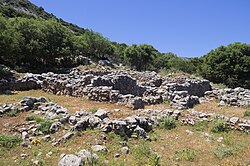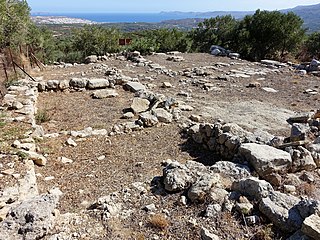
Sklavokampos (also Sklavokambos) is the archaeological site of an ancient Minoan settlement in Crete, used during the Late Minoan period.

Sklavokampos (also Sklavokambos) is the archaeological site of an ancient Minoan settlement in Crete, used during the Late Minoan period.
Sklavokampos is southwest of Tylissos, at the road that connects in with Anogeia, 22 kilometres from Heraklion. It is a valley near Gonies gorge.
The site was discovered while constructing a road to Anogeia and was first excavated in the 1930s.
A multiple-story building was found at the site. Its main room yielded a clay ox head, a LMIB style jug and a stone rhyton. The building had at least 17 rooms. Finds from an upper story included 39 sealings, a cylindrical vessel, a stone hammer and a clay foot. Seal impressions from one the Sklavokampos sealings have been found in Zakros, Gournia and Hagia Triada.
No frescoes or gypsum finishings, which are commonly found in Minoan palaces, were found at the Sklavokampos building.

Pyrgos is an archaeological site of the Minoan civilization near Myrtos in the municipality of Ierapetra on the south coast of Crete. Pyrgos provides evidence of settlements along the southern Ierapetra Isthmus. This site has had a long history due to its valuable location and geography. It is located close to the Myrtos valley and has a harbor with a nearby mountain range providing its protection. The settlement includes a courtyard, many rooms, a country house and a tomb.

Pseira is an islet in the Gulf of Mirabello in northeastern Crete with the archaeological remains of Minoan and Mycenean civilisation.

Karfi is an archaeological site high up in the Dikti Mountains in eastern Crete, Greece. The ancient name of the site is unknown; "Karfi" is a local toponym for the prominent knob of limestone that marks the peak of the site, especially when viewed from the north. Located approximately 1100 meters above sea level, and overlooking the northern entrance to the Lasithi Plateau, the dramatic situation of Karfi is somewhat akin to that of the famous Inca site of Machu Picchu in Peru. While there is some evidence that the site was used during the Middle Minoan period as a peak sanctuary, Karfi is best known as a large and extensively excavated town of the Late Minoan IIIC period at the beginning of the Greek "Dark Ages."
Apodoulou is the archaeological site of an ancient Minoan mansion or ceremonial building.

Vasiliki is the name of a village in the municipality of Ierapetra, in the prefecture of Lasithi, on Crete, and the name of the nearby Minoan archeological site. The site took its name from the village.

Achladia is the archaeological site of an ancient Minoan villa on eastern Crete.

Petras is the archaeological site of an ancient Minoan town on northeastern Crete. It includes a building which shows strong similarities with Minoan palaces and is sometimes labeled as a palace.
Prassa is the archaeological site of an ancient Minoan settlement on Crete.

Phourni is the archaeological site of an ancient Minoan cemetery in Crete, established in 2400 BC and lasted until 1200 BC. Phourni is Greek for "furnace, oven" and the name of the hill on which the cemetery is located. Phourni is located at 70100 Epano Archanes, Heraklion, Greece—located on a hill in north-central Crete. Phourni can be seen from Mount Juktas. It is a small hill situated northwest of Archanes, between Archanes and Kato Archanes. Phourni is reachable from a signed scenic path that starts at Archanes. It was an important site for Minoan burials. The burials consistently and proactively engaged the community of the Minoans. The largest cemetery in the Archanes area was discovered in 1957 and excavated for 25 years by Yiannis Sakellarakis, beginning in 1965. The 6600 sq m cemetery includes 26 funerary buildings of varying shapes and sizes. The necropolis of Phourni is of primary importance, both for the duration of its use and for the variety of its funerary monuments. All the pottery and much of the skeletal material was collected, unlike many other pre-palatial tombs. The cemetery was founded in the Ancient Minoan IIA, and continued to be used until the end of the Bronze Age. The occupation reached its peak during the Middle Minoan AI, just before the palaces of Knossos and Malia appeared. The proximity of Archanes to the important religious centres of Mount Iuktas probably contributed to the prominence of the site.

Monastiraki is the archaeological site of an ancient Minoan town on the island of Crete. The site is on the plain of Amari, west of the Ida massif, 38 kilometres from Rethymnon.
Tripiti is the archaeological site of an ancient Minoan settlement in southern Crete, Greece. It is located in the Mesara Plain along the coast to the east of the village of Lendas.
Apesokari is the archaeological site of an ancient Minoan cemetery. It is also a modern village with a population of 76 (2021) and is built at 155 m above sea level. It is in the municipality of Gortyna in the south of Heraklion regional unit, Greece.
Odigitria is the archaeological site of an ancient Minoan religious complex including two tholos tombs located near the modern Odigitria Monastery in the Asterousia mountains of southern Crete.
Yerokambos is the archaeological site of an ancient Minoan cemetery in central Crete.

Armeni is the archaeological site of an ancient Minoan cemetery on Crete, roughly eight kilometers south of the modern town of Rethymnon.
Phylaki is a modern village and the archaeological site of an ancient Minoan cemetery on Crete.

Stylos is an archaeological site of an ancient Minoan settlement and cemetery near the modern village of Stylos on the Greek island of Crete. Stylos means "column" in Greek. Stylos is near the important archaeological site of Aptera in Chania regional unit. The site was first excavated by N. Platon and C. Davaras. A potter's kiln, a building with four rooms and a Late Minoan tholos tomb have been excavated.

Hagia Photia is an archaeological site of a fortified ancient Minoan building on eastern Crete. Sitia lies five kilometers to the west.

Vathypetro is an archaeological site, four kilometres south of the town of Archanes on Crete (Greece). It contains some of the oldest wine presses in the world. Excavations began in 1949 by the Greek archaeologist Spyridon Marinatos. The estate contains a manor house or villa which had a prominent role in the rural region around Archanes. The complex consists of several buildings, courtyards and workshop spaces. Next to the individual houses is the Minoan wine press, a plant for the production of olive, a Minoan kiln and ceramics, and the remains of an ancient pottery workshop.

Chamaizi is an ancient archaeological site in eastern Crete with the only known oval-shaped building of the Minoan period. Below this building is evidence of Early Minoan building foundations.